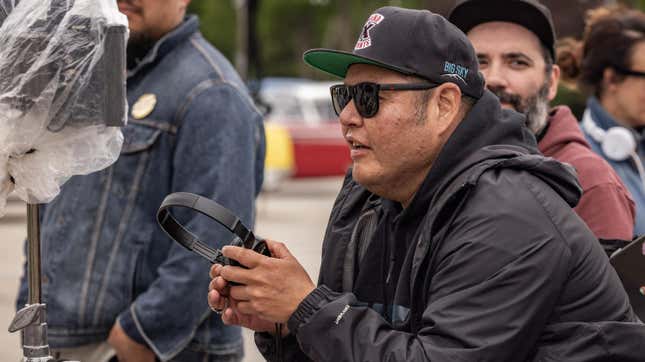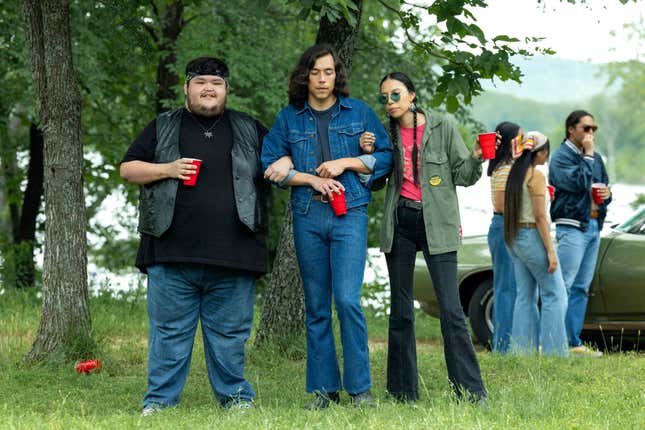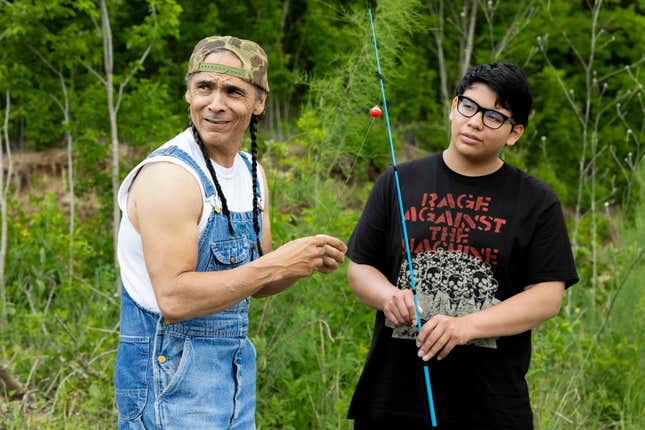
As it nears its final run of episodes, Reservation Dogs continues to prove why it’s one of the funniest and most ambitious television series around. Ostensibly following its titular teenage protagonists as they navigate the world of Okern, Oklahoma, this Sterlin Harjo- and Taika Waititi-created FX comedy has emerged as an increasingly broad-ranging show about friendship and community—all while showcasing the talent (in front and behind the camera) of a fresh-voiced new generation of Native artists.
That was perhaps nowhere most obvious than in this season’s “House Made Of Bongs,” an episode that took us all the way back to 1976 and introduced us to Bucky, Brownie, Irene, Mabel, and Fixico as rowdy teenagers who had dreams and aspirations not unlike those of Bear, Elora, Cheese and Willie Jack. That episode, and the one that followed (“Frankfurter Sandwich”), ran the gamut of what’s made Reservation Dogs such a thrilling 21st century instant classic: One served as a ’70s stoner comedy, the other culminated in a cry session between three grown men out in the woods.
Comedy and drama, absurdity and pathos. There’d be whiplash if the show wasn’t so well-shepherded by the likes of Blackhorse Lowe, the director behind those back-to-back installments. The A.V. Club caught up with Lowe to talk about his artistic journey as part of Reservation Dogs; why he so connects with the likes of Cheese, Bucky and Uncle Brownie; and how he adds genre trappings into this teen-driven series.
The A.V. Club: Over the course of three seasons, you’ve closely followed Cheese, Brownie, and Big—and here again you’ve gotten to direct two episodes that dovetail and expand their stories. Do you find yourself having a special kinship with these characters?
Blackhorse Lowe: Yeah, I think with Sterlin Harjo, the showrunner, he very much caters to the directors’ and writers’ tastes and what their strengths are. So I think he definitely knew to give me the Uncle Brownie character and especially with Cheese and then Zahn [who plays Officer Big] just because—you know, [they’re] single dudes who are going through their stuff (which I definitely am), but also have their own baggage that they deal with. Also, it’s still all very much a genre world, where it’s like stoner comedy, an action adventure kind of cult thing with the fish fucking episode and dealing with Cheese going through his angsty teenage-hood and being like this weirdo, smarter-than-his-years kind of a kid. All these characters individually really speak to me, just in terms of what they’re going through. But also in terms of the genre context they very much fit into what I like to do—everything from stoner to horror films. So it’s very nice, especially getting to work with [Kaniehtiio] Horn, who plays Deer Lady. It’s always nice that they think of me when they write these scripts. When I did the second season, it was like, Oh, genre stuff? Give it to Blackhorse! Something with acid? Give it to Blackhorse! There’s something crazy? Give it to Blackhorse! So it’s nice to get that type of pigeonhole.
AVC: Yeah, you’ve also definitely become the go-to director for drug-fueled episodes: We had the weed one in season one (“Uncle Brownie”), then the psychedelics one in season two (“This is Where the Plot Thickens”) and now this ’70s stoner/LSD one (“House Made of Bongs”).
BL: The funny thing is I’ve never done drugs in my life!
AVC: Wait, really?
BL: [Laughs] That’s what I tell the kids.
AVC: Speaking of kids, “House Made Of Bongs” takes us back to the late 1970s and we meet some of the elders we know really well and see them as high-school teenagers. What was most exciting about getting that script?
BL: Yeah, well, just seeing that it was the ’70s and knowing Sterlin’s taste in terms of what he liked from ’70s cinema, which is exactly what I love. Everything from like Two-Lane Blacktop to Vanishing Point, and even earlier stuff like, oh god, George Lucas’ movie with the kids in set in the 1960s trying to have fun, American…

AVC: American Graffiti.
BL: American Graffiti! And Dazed Confused—everything was pretty much in that type of vibe, too. It just felt like it was kind of like a reset for the season. Because these are the characters that originally established everyone to where they are right now. It felt like a pilot on its own. So it was nice to kind of reestablish the look and take it to a different place that it hadn’t been, visually. A lot of stuff that we use, like oh, you know, anamorphic primes and really tried to lean into the ’70s look and aesthetic, especially in terms of how the story was told. But also just getting to explore these characters, like Irene and young Bucky, even young Brownie, and seeing all these hopes and dreams they had and how it all kind of came crashing down or came into reality, I should say. It’s nice to explore those characters and actually make them a bit fuller when they’re teenagers, seeing them do drugs and having all these aspirations of what they wanted to do in their lives.
AVC: Talk to me about casting this episode and working with these young actors who had a bit of a tricky tone to hit in playing characters we’ve already met.
BL: Oh, yeah, especially with Mato [Wayuhi], who played Bucky’s character based on Wes Studi. He got his mannerisms down to T, with the hand flipping and everything. Especially in his inflection and his cadence and everything, he just knocked out the part. And then with the other actors ... Quannah Chasinghorse, as young Irene: She was just amazing, because she looked almost exactly like [Irene actor] Casey Camp-Horinek in her twenties. When they actually put pictures of them together, they looked exactly like one another. I think the actors went above and beyond what they knew about the characters and created their own backstories and everything. They really knocked it out of the park, especially when it came to working with young Maximus. Because his character is established in this season. So he really had to make the character on his own and make something completely different from everything else that had been established, and he just like James Dean’d it up. I was very happy about that, too. And, you know, we brought in Paulina Alexis’ brother to play the younger version of Brownie, and he just like, with Mato, he got the cadence, the rhythms, and everything. It was beautiful to take a trip back with all these characters.
AVC: Given how episode five ends—with a visit from an alien—I wanted to talk a bit about this genre feel of your work within the context of Reservation Dogs. What do you think you’re bringing into the world of the show with these genre flourishes?
BL: Yeah, I think genre narratives are really the best ones to tell stories of oppression or colonization or anything like that. They Live, Invasion of the Body Snatchers? They’re always taking these big themes and kind of compressing them into these nice nuggets of action or sci-fi or whatever. That’s the thing that I love about genre. I love watching John Carpenter; like The Thing was always on repeat at my house. I was all about watching all those films with my other cousins and my brothers and sisters and my father. It’s all about action and genre. I got to know that very well in my youth and then into my later years I started discovering art films, Tarkovsky and Kurosawa and all those guys. So now it’s just kind of a weird blend. But every time they want me to do genre, I’m just like, Yes! I can finally stretch that muscle! Because everything I did previously, in my independent-film years, was all self-financed: People talking in rooms, very low budget, whatever I could make happen. So it’s nice to have the budget and the support to really kind of flex that muscle and just really do big moments, like having the alien sequence at the end, in which we’re referencing Spielberg and early Carpenter. It’s all these different movie references and stuff I love; they came out onto the screen naturally, too. It really speaks to the strength of Sterlin as a showrunner and as leader. He really knows every one of his artists as directors, writers, and actors—like what they can do and how much he could push them. I’m very thankful he just kind of throws me into it and lets me do my thing.

AVC: Watching episodes five and six together felt like a beautiful double feature in the way they fleshed out Maximus’ storyline. Did they feel like two stories that spoke to one another that way to you?
BL: I think it did after I came away from set. Actually seeing the material and editing it and seeing how well they’re paired. But at the time, I was so much in the moment of being in the woods and shooting with Gary Farmer, Wes Studi, Zahn McClarnon … You know, we’re trying to deal with ticks or dealing with rain, like all these other issues. So I wasn’t really conscious of that until it came to editing. But it’s just nice to see how they’re paired up and following that emotional line of Maximus and how it has affected these men. Starting with the ’70s episode and then ending in this big group crying session that gets going and all of a sudden, it all makes sense. It was beautiful to not be conscious of it, but instead just lead the actors emotionally through where they needed to go.
AVC: How was it getting them to that really emotional climax at the end of the episode?
BL: It was a beautiful thing. It really was one of the classic Reservation Dogs scenes where it’s like: People walk in the woods and slowly have this revelation of emotion and a deeper understanding of each other and the world. It was just a lovely thing, especially working with Wes, Gary, Zahn and Lane. They joke around and cut each other down, too. So the comfortability was already there. So I really didn’t have to work much. I just had to give them little cues, like a bit bigger here, a bit smaller there. In terms of me directing them to get to those emotional moments, we, as Native people, have a somewhat similar spiritual upbringing to a certain degree in terms of traditions and stuff. So when I was directing those scenes, I mentioned certain ceremonies, and they were like, Oh, we get it. For me, I went to ceremonies when I was younger because my father’s a medicine man. So I’ve always seen these revelations, seen these people opening up their heart and souls, which always starts very gruff, and standoffish, and by the end of it, like, some laughter happens, and all of a sudden, everyone’s just crying, and it turns into healing and everything else. I identified [with] that emotion and I knew I had to put it in the show but within these characters. I knew finally how to make it work. Because when they first read it, it was just like, alright, four men go into the woods and then they cry at the end. When we actually got into it was like, Okay, this is what it means. And this is what’s happening to each of these characters individually, like Cheese finding his own, realizing his importance to the Rez Dogs—knowing that he’s wanted, that he’s loved. And these three older men realizing their foibles and how they messed up with Maximus earlier on and seeing these parallels between them and Cheese. I mean, it’s so beautiful to see them finally find, to a certain degree, a kind of resolution.
AVC: Speaking of resolution, as you look back on your work on Reservation Dogs, what are you taking away?
BL: So many things. But the sense of family, I think, is the big thing. I have to say that the community there and especially the filmmaking community in Tulsa, Oklahoma, is just so tight; everyone really knows one another. Everyone hangs out with one another, and connects with one another, drinks with one another, smokes weed with one another—it was just very much a family environment. You really don’t get to live an experience like that on other sets. You know, your day begins with prayer, it starts with everyone and how they’re feeling. And then when you go through the day there’s no real hierarchy. It’s just artists collaborating with each other, which is very much a joyous thing. But also the paycheck was very nice. Oh, and I finally got medical and dental insurance, which I’m very happy about.